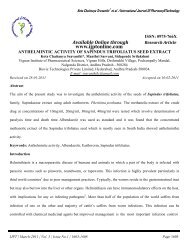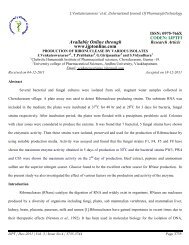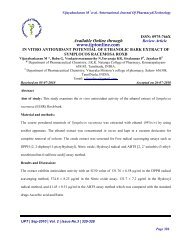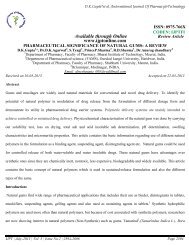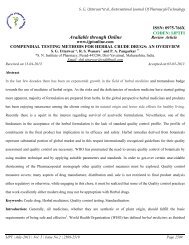SK Gupta* et al. /International Journal Of Pharmacy&Technology
SK Gupta* et al. /International Journal Of Pharmacy&Technology
SK Gupta* et al. /International Journal Of Pharmacy&Technology
- No tags were found...
You also want an ePaper? Increase the reach of your titles
YUMPU automatically turns print PDFs into web optimized ePapers that Google loves.
S.K.<strong>Gupta*</strong> <strong>et</strong> <strong>al</strong>. /Internation<strong>al</strong> Journ<strong>al</strong> <strong>Of</strong> Pharmacy&<strong>Technology</strong>Reason of gastric ulcer:1. Helicobacter pilori: Helicobacter Pylori is a curved or “s” shaped gram-negative bacillus with 4-6 lophotrichoussheathed flagella. Pylori is found primarily is the deep portions of the mucus gel layer that coats the gastric mucosaand b<strong>et</strong>ween the mucus gel layer and apic<strong>al</strong> mucos<strong>al</strong> epitheli<strong>al</strong> cells It pylori may adverse to the lumin<strong>al</strong> surface ofgastric epitheli<strong>al</strong> cells but does not invade the gastric mucosa 4Pathophysiology:H. Pylori produce a vari<strong>et</strong>y of proteins that appear to mediate or facilitate its damaging effect on his gastric mucosa.Urease produced by H. Pylori cat<strong>al</strong>yzed the hydrolysis of urea to ammonia and carbon dioxide.H. Pylori ureaseUrea Ammonia + CO 2Production of urease is required for gastric colorization by H. Pylori and may protect it. Pylori from theeffect of gastric acid, which norm<strong>al</strong>ly prevents gastric colorizations by either bacterium, hydroxide ion generated bythe equilibration of water with ammonia may contribute to gastric mucos<strong>al</strong> epitheli<strong>al</strong> damage.2. Decrement in gastric Defense:The stomach protects itself from damage by gastric acid through sever<strong>al</strong> mechanisms such as the presence ofintercellular tight junctions b<strong>et</strong>ween the gastric epitheli<strong>al</strong> cells, the presence of a mucin layer overlying the gastricepitheli<strong>al</strong> cells, the presence of prostaglandins in the gastric mucosa, and secr<strong>et</strong>ion of bicarbonate ions into themucin layer. Prostaglandins, E 2 and I 2 inhibit gastric acid secr<strong>et</strong>ion by a direct effect on the pari<strong>et</strong><strong>al</strong> cell mediated bythe EP 3 receptor 11 .THERAPY/TREATMENT:(A) Therapy for liver disease includes <strong>al</strong>lopathic and herb<strong>al</strong> drug treatment(1) Hepatoprotective <strong>al</strong>lopathic treatment: Specific drugs used in the management of liver disease:(i) Ursodeoxycholic acid (Ursodiol):IJPT | March-2011 | Vol. 3 | Issue No.1 | 824-853 Page 831



